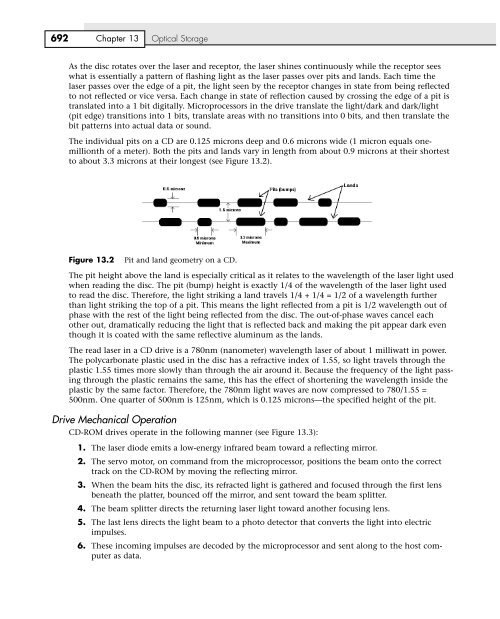Create successful ePaper yourself
Turn your PDF publications into a flip-book with our unique Google optimized e-Paper software.
692 Chapter <strong>13</strong> Optical Storage<br />
As the disc rotates over the laser and receptor, the laser shines continuously while the receptor sees<br />
what is essentially a pattern of flashing light as the laser passes over pits and lands. Each time the<br />
laser passes over the edge of a pit, the light seen by the receptor changes in state from being reflected<br />
to not reflected or vice versa. Each change in state of reflection caused by crossing the edge of a pit is<br />
translated into a 1 bit digitally. Microprocessors in the drive translate the light/dark and dark/light<br />
(pit edge) transitions into 1 bits, translate areas with no transitions into 0 bits, and then translate the<br />
bit patterns into actual data or sound.<br />
The individual pits on a CD are 0.125 microns deep and 0.6 microns wide (1 micron equals onemillionth<br />
of a meter). Both the pits and lands vary in length from about 0.9 microns at their shortest<br />
to about 3.3 microns at their longest (see Figure <strong>13</strong>.2).<br />
Figure <strong>13</strong>.2 Pit and land geometry on a CD.<br />
The pit height above the land is especially critical as it relates to the wavelength of the laser light used<br />
when reading the disc. The pit (bump) height is exactly 1/4 of the wavelength of the laser light used<br />
to read the disc. Therefore, the light striking a land travels 1/4 + 1/4 = 1/2 of a wavelength further<br />
than light striking the top of a pit. This means the light reflected from a pit is 1/2 wavelength out of<br />
phase with the rest of the light being reflected from the disc. The out-of-phase waves cancel each<br />
other out, dramatically reducing the light that is reflected back and making the pit appear dark even<br />
though it is coated with the same reflective aluminum as the lands.<br />
The read laser in a CD drive is a 780nm (nanometer) wavelength laser of about 1 milliwatt in power.<br />
The polycarbonate plastic used in the disc has a refractive index of 1.55, so light travels through the<br />
plastic 1.55 times more slowly than through the air around it. Because the frequency of the light passing<br />
through the plastic remains the same, this has the effect of shortening the wavelength inside the<br />
plastic by the same factor. Therefore, the 780nm light waves are now compressed to 780/1.55 =<br />
500nm. One quarter of 500nm is 125nm, which is 0.125 microns—the specified height of the pit.<br />
Drive Mechanical Operation<br />
CD-ROM drives operate in the following manner (see Figure <strong>13</strong>.3):<br />
1. The laser diode emits a low-energy infrared beam toward a reflecting mirror.<br />
2. The servo motor, on command from the microprocessor, positions the beam onto the correct<br />
track on the CD-ROM by moving the reflecting mirror.<br />
3. When the beam hits the disc, its refracted light is gathered and focused through the first lens<br />
beneath the platter, bounced off the mirror, and sent toward the beam splitter.<br />
4. The beam splitter directs the returning laser light toward another focusing lens.<br />
5. The last lens directs the light beam to a photo detector that converts the light into electric<br />
impulses.<br />
6. These incoming impulses are decoded by the microprocessor and sent along to the host computer<br />
as data.
















